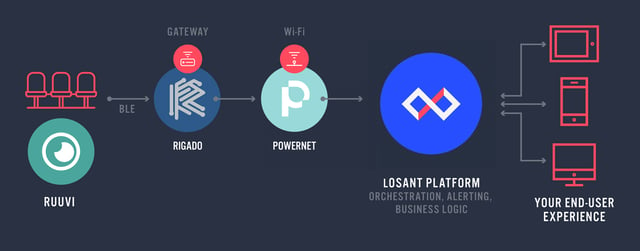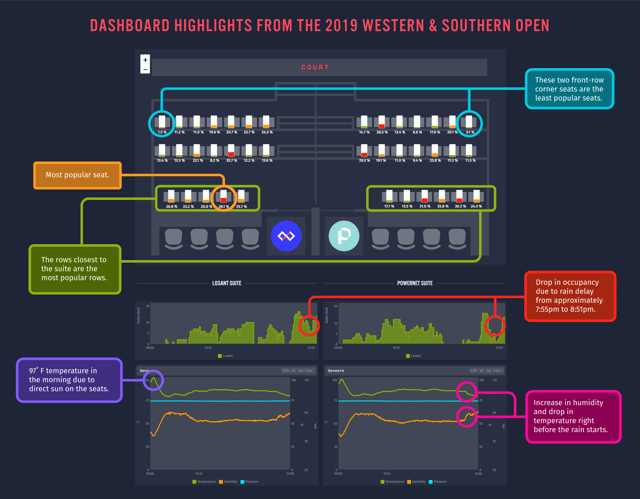Stadium operators are in a head-to-head battle against a fan's at-home experience. To win this battle, stadiums are investing in technology to make their facilities more efficient, engaging, and safe. In order to innovate, however, you must first understand your environment, and how fans interact with it, in order to make targeted investments in technology where it matters the most.
At this year's Western & Southern Open, we applied our smart environment technology to the stadium experience. In order to generate this data, we joined forces with our partner, Powernet, who provides all of the stadium's internet and WiFi. Powernet and Losant had a pair of side-by-side suites that we outfitted with sensors to track individual seat utilization throughout the day.
Real-Time Smart Stadium Insights
Below is a short video that demonstrates how we used IoT to capture seat occupancy information over the course of twelve hours.
The top section is a live view of the occupied status of each seat. Green is available. Red is occupied. You can definitely see when the more popular matches took place. Each individual seat sensor also reported temperature, humidity, and atmospheric pressure, which we're displaying on the gauges and charts beneath the seat layout.
Seeing a condensed view of traffic flow like this, stadium-wide, provides insights that lead to optimized security, concessions, and placement of new fan experiences. This dashboard also provides a real-time and instant view into where your fans are at any moment in time, greatly improving the effectiveness of security and first-responder teams.
Historical Smart Stadium Insights
Besides providing real-time visibility, you can also look at aggregated data once the event is over, which provides an entirely new level of insights into your smart stadium or smart environment.
The image above is showing historical and aggregated data over the course of a day: 9 a.m. to 9 p.m. This view yields some very interesting insights:
- The corner seats in the front row are by far the least popular.
- The row closest to the suite was used much more than any other row.
- The rain delay caused a noticeable drop in occupancy.
- The morning sun caused the seats to reach 97 degrees, so morning matches may have been a little uncomfortable.
IoT Architecture of a Smart Stadium
For this implementation, we applied the same technology that has been successful in other smart environment scenarios. We used Ruuvi sensors and our partners Rigado and Powernet for the hardware, gateways, and connectivity. Losant's application enablement platform was used to collect, aggregate, and present the live and historical data.

This solution follows our Fundamental IoT Architecture. The Ruuvi sensors, which were installed on every seat, reported data to the local Rigado gateways over Bluetooth. The data was backhauled to the Losant platform using the WiFi provided by Powernet. The IoT application was created using Losant's workflows and dashboards.
Additional Smart Stadium Opportunities
Even with this small installation, the data we received yielded significant insights into how fans interact with a suite environment. The same seat utilization sensors, deployed stadium-wide, can offer a wealth of additional information about how traffic flows through your environment. It may also present an opportunity for stadium seat resales or dynamic ticket pricing. Sensor costs have been dropping rapidly and we're now at a time where it is cost-effective to deploy solutions like this across tens of thousands of seats.
Tracking seats is only one source of information about where people are in a stadium. There now exists off-the-shelf sensors that can anonymously track the location of people walking through halls, standing in concession lines, waiting in ticket lines, and many other places that have a significant impact on fan experience. Implementing the technology to understand your environment provides the groundwork for experimentation and innovation that results in a more efficient, engaging, and safe stadium environment for your fans.
If you'd like to learn more about how Losant and our partners can help improve your smart stadium or other smart environment, please contact us to schedule a call with one of our solution experts.

